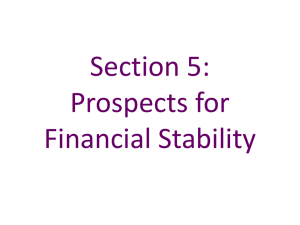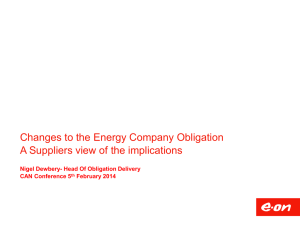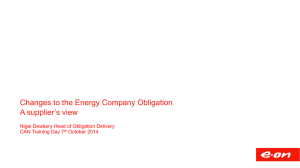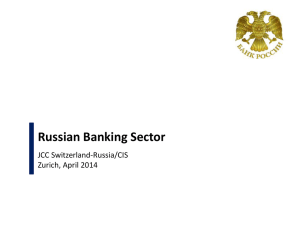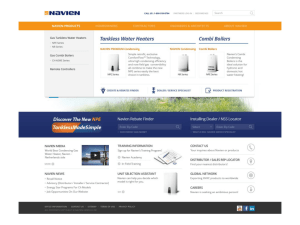CA DISCLOSURE.xls - ECB Banking Supervision
advertisement
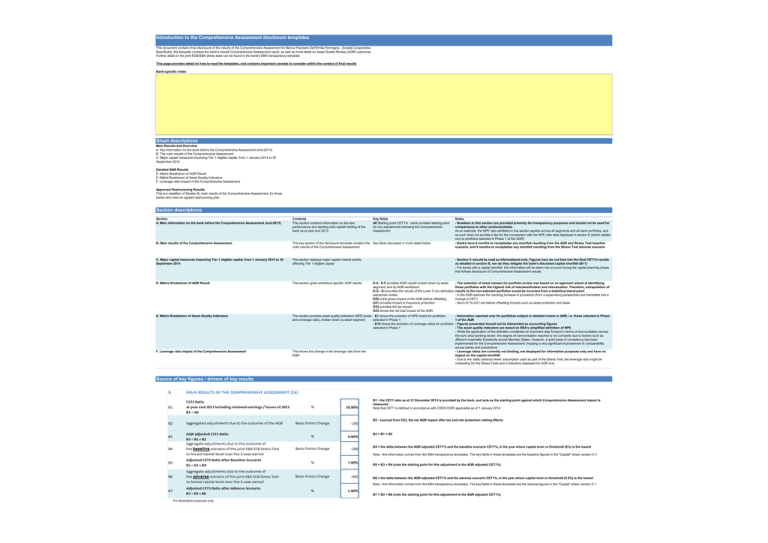
Introduction to the Comprehensive Assessment disclosure templates This document contains final disclosure of the results of the Comprehensive Assessment for Banca Popolare Dell'Emilia Romagna - Società Cooperativa Specifically, the template contains the bank's overall Comprehensive Assessment result, as well as more detail on Asset Quality Review (AQR) outcomes Further detail on the joint ECB-EBA stress tests can be found in the bank's EBA transparency template This page provides detail on how to read the templates, and contains important caveats to consider within the context of final results Bank-specific notes - Sheet descriptions Main Results and Overview A. Key information on the bank before the Comprehensive Assessment (end-2013) B. The main results of the Comprehensive Assessment C. Major capital measures impacting Tier 1 eligible capital, from 1 January 2014 to 30 September 2014 Detailed AQR Results D. Matrix Breakdown of AQR Result E. Matrix Breakdown of Asset Quality Indicators F. Leverage ratio impact of the Comprehensive Assessment Approved Restructuring Results This is a repetition of Section B, main results of the Comprehensive Assessment, for those banks who have an agreed restructuring plan Section descriptions Section A. Main information on the bank before the Comprehensive Assessment (end-2013) Contents This section contains information on the size, performance and starting point capital holding of the bank as at year-end 2013 Key fields A6 Starting point CET1% - bank provided starting point for any adjustments following the Comprehensive Assessment Notes - Numbers in this section are provided primarily for transparency purposes and should not be used for comparisons to other sections/sheets. As an example, the NPE ratio exhibited in this section applies across all segments and all bank portfolios, and as such does not provide a like for like comparison with the NPE ratio data displayed in section E (which relates only to portfolios selected in Phase 1 of the AQR) - Banks have 6 months to recapitalise any shortfall resulting from the AQR and Stress Test baseline scenario, and 9 months to recapitalise any shortfall resulting from the Stress Test adverse scenario B. Main results of the Comprehensive Assessment This key section of the disclosure template contains the Key fields discussed in more detail below main results of the Comprehensive Assessment C. Major capital measures impacting Tier 1 eligible capital, from 1 January 2014 to 30 September 2014 This section displays major capital market activity affecting Tier 1 eligible capital D. Matrix Breakdown of AQR Result This section gives workblock specific AQR results D.A - D.F provides AQR results broken down by asset segment, and by AQR workblock D.G - D.I provides the results of the Level 3 non-derivative exposures review D20 is the gross impact of the AQR before offsetting D21 provides impact of insurance protection D22 provides the tax impact D23 shows the net total impact of the AQR - The selection of asset classes for portfolio review was based on an approach aimed at identifying those portfolios with the highest risk of misclassification and misvaluation. Therefore, extrapolation of results to the non-selected portfolios would be incorrect from a statistical stand-point - In the AQR exercise the resulting increase in provisions (from a supervisory perspective) are translated into a change in CET1 - Items D1 to D21 are before offsetting impacts such as asset protection and taxes E. Matrix Breakdown of Asset Quality Indicators The section provides asset quality indicators (NPE levels - E1 shows the evolution of NPE levels for portfolios and coverage ratio), broken down by asset segment selected in Phase 1 - E10 shows the evolution of coverage ratios for portfolios selected in Phase 1 F. Leverage ratio impact of the Comprehensive Assessment This shows the change in the leverage ratio from the AQR - Information reported only for portfolios subject to detailed review in AQR, i.e. those selected in Phase 1 of the AQR - Figures presented should not be interpreted as accounting figures - The asset quality indicators are based on EBA’s simplified definition of NPE - While the application of this definition constitutes an important step forward in terms of harmonisation across the euro area banking sector, the degree of harmonisation reached is not complete due to factors such as different materiality thresholds across Member States. However, a solid basis of consistency has been implemented for the Comprehensive Assessment, implying a very significant improvement in comparability across banks and jurisdictions - Leverage ratios are currently not binding, are displayed for information purposes only and have no impact on the capital shortfall - Due to the ‘static balance sheet’ assumption used as part of the Stress Test, the leverage ratio might be misleading for the Stress Tests and is therefore displayed for AQR only - Section C should be read as informational only. Figures here do not feed into the final CET1% results as detailed in section B, nor do they mitigate the bank's disclosed capital shortfall (B11) - For banks with a capital shortfall, this information will be taken into account during the capital planning phase that follows disclosure of Comprehensive Assessment results Source of key figures / drivers of key results B1 - the CET1 ratio as at 31 December 2013 is provided by the bank, and acts as the starting point against which Comprehensive Assessment impact is measured Note that CET1 is defined in accordance with CRDIV/CRR applicable as of 1 January 2014 B2 - sourced from D23, the net AQR impact after tax and risk protection netting effects B3 = B1 + B2 B4 = the delta between the AQR adjusted CET1% and the baseline scenario CET1%, in the year where capital level vs threshold (8%) is the lowest Note - this information comes from the EBA transparency templates. The key fields in these templates are the baseline figures in the "Capital" sheet, section C.1 B5 = B3 + B4 (note the starting point for this adjustment is the AQR adjusted CET1%) B6 = the delta between the AQR adjusted CET1% and the adverse scenario CET1%, in the year where capital level vs threshold (5.5%) is the lowest Note - this information comes from the EBA transparency templates. The key fields in these templates are the adverse figures in the "Capital" sheet, section C.1 B7 = B3 + B6 (note the starting point for this adjustment is the AQR adjusted CET1%) For illustrative purposes only 2014 COMPREHENSIVE ASSESSMENT OUTCOME ECB PUBLIC NAME OF THE ENTITY ITBPER Banca Popolare Dell'Emilia Romagna - Società Cooperativa 1 Main Results and Overview A MAIN INFORMATION ON THE BANK BEFORE THE COMPREHENSIVE ASSESSMENT (end 2013) END 2013 A1 Total Assets (based on prudential scope of consolidation) Mill. EUR 61,759.00 A2 Net (+) Profit/ (-) Loss of 2013 (based on prudential scope of consolidation) Mill. EUR 6.00 A3 Common Equity Tier 1 Capital according to CRDIV/CRR definition, transitional arrangements as of 1.1.2014 Mill. EUR 3,965.98 A4 Total risk exposure * according to CRDIV/CRR definition, transitional arrangements as of 1.1.2014 Mill. EUR 43,344.00 A5 Total exposure measure according to Article 429 CRR "Leverage exposure" Mill. EUR 65,319.98 A6 CET1 ratio according to CRDIV/CRR definition, transitional arrangements as of 1.1.2014 A6=A3/A4 % 9.15% A7 Tier 1 Ratio (where available) according to CRD3 definition, as of 31.12.2013 as reported by the bank % 8.61% A8 Core Tier 1 Ratio (where available) according to EBA definition % 8.56% A9 Leverage ratio % 6.11% A10 Non-performing exposures ratio % 11.88% A11 Coverage ratio for non-performing exposure % 35.82% A12 Level 3 instruments on total assets % 0.82% B MAIN RESULTS OF THE COMPREHENSIVE ASSESSMENT (CA) B1 CET1 Ratio at year end 2013 including retained earnings / losses of 2013 B1 = A6 B2 Aggregated adjustments due to the outcome of the AQR B3 AQR adjusted CET1 Ratio B3 = B1 + B2 B4 Aggregate adjustments due to the outcome of the baseline scenario of the joint EBA ECB Stress Test to lowest capital level over the 3-year period B5 Adjusted CET1 Ratio after Baseline Scenario B5 = B3 + B4 B6 Aggregate adjustments due to the outcome of the adverse scenario of the joint EBA ECB Stress Test to lowest capital level over the 3-year period B7 Adjusted CET1 Ratio after Adverse Scenario B7 = B3 + B6 Capital Shortfall % Basis Points Change % 9.15% -78 8.37% Basis Points Change % Basis Points Change % -4 8.33% -316 5.22% Basis Points 1 Mill. EUR B8 to threshold of 8% for AQR adjusted CET1 Ratio 0 0.00 B9 to threshold of 8% in Baseline Scenario 0 0.00 28 127.60 28 127.60 B10 to threshold of 5.5% in Adverse Scenario B11 Aggregated Capital Shortfall of the Comprehensive Assessment B11 = max( B8, B9, B10 ) * Total risk exposure figure is pre-AQR. Please note that the corresponding Year End 2013 figure in the EBA Transparency template is post-AQR and therefore may not match exactly. 1 RWA used corresponds to relevant scenario in worst case year Overview AQR Overview Baseline Overview Adverse 10% 9% 0.78% 0.04% 8% 7% 3.16% 6% 5% 9.15% 4% 8.37% 8.33% 8.37% 3% 5.22% 2% 1% 0% CET 1 Ratio at year Aggregated AQR adjusted CET1 Aggregate Adjusted CET1 Ratio AQR adjusted CET1 end 2013 including adjustments due to Ratio adjustments due to after Baseline Ratio retained earnings / the outcome of the the outcome of the Scenario losses of 2013 AQR baseline scenario of the joint EBA ECB Stress Test C Aggregate Adjusted CET1 Ratio adjustments due to after Adverse the outcome of the Scenario adverse scenario of the joint EBA ECB Stress Test MAJOR CAPITAL MEASURES IMPACTING TIER 1 ELIGIBLE CAPITAL FROM 1 JANUARY 2014 TO 30 SEPTEMBER 2014 Issuance of CET1 Instruments Impact on Common Equity Tier 1 Million EUR C1 Raising of capital instruments eligible as CET1 capital C2 Repayment of CET1 capital, buybacks 0.00 C3 Conversion to CET1 of hybrid instruments becoming effective between January and September 2014 0.00 Net issuance of Additional Tier 1 Instruments 759.14 Impact on Additional Tier 1 Million EUR C4 with a trigger at or above 5.5% and below 6% 0.00 C5 with a trigger at or above 6% and below 7% 0.00 C6 with a trigger at or above 7% 0.00 Fines/Litigation costs C7 Incurred fines/litigation costs from January to September 2014 (net of provisions) Million EUR -10.12 2014 COMPREHENSIVE ASSESSMENT OUTCOME ECB PUBLIC NAME OF THE ENTITY ITBPER Banca Popolare Dell'Emilia Romagna - Società Cooperativa 2. Detailed AQR Results D. Matrix Breakdown of AQR Result (B2) Note: • The selection of asset classes for portfolio review was based on an approach aimed at identifying those portfolios with the highest risk of misclassification. Therefore, extrapolation of results to the non-selected portfolios would be incorrect. • The columns D. C to D .F include (but are not limited to) any impacts on provisioning associated with the reclassification of performing to non-performing exposure. • In the AQR exercise the resulting increase in provisions (from a supervisory perspective) are translated into a change in CET1. • Items D1 to D21 are before offsetting impacts such as asset protection and taxes. • Basis points are calculated using total risk exposure from Section A4 • For the interpretation of the detailed results the interested reader may refer to the AQR manual outlining the methodology or to the accompanying Aggregate Report where the main features of the CA exercise are reiterated. Find the AQR manual here: http://www.ecb.europa.eu/press/pr/date/2014/html/pr140311.en.html 84.90 44.32 26.65 -45 -39 -27 -193.14 -169.58 -116.95 0.00 43 0 184.85 0.00 32 0 Additional information on portfolios with largest adjustments accounting for (at least) 30% of total banking book AQR adjustment: Asset Class Geography Large SME (non real estate) ITALY 8,317.40 14 Real estate related ITALY 6,692.60 14 6,440.70 Large corporates (non real estate) ITALY 14 61.91 62.42 60.51 11 14 7 Mill. EUR 0 Mill. EUR 0.00 before any offsetting impact Basis Points Impact on CET1 capital 20 10 6 0 due to collective provisioning review Mill. EUR Basis Points Adjustment to provisions 46.33 62.84 29.79 provisions due to projection of findings provisions on sampled files -479.67 0.00 0.00 0.00 0.00 0.00 0.00 -479.67 0.00 138.95 0.00 0.00 0.00 36,147.00 120.20 2,407.90 10,501.50 5,855.20 2,935.70 1,710.60 22,550.80 566.60 Basis Points Adjustments to -111 0 0 0 0 0 0 -111 0 Basis Points Adjustments to D10 138.95 0.00 155.87 0.00 0.00 0.00 0.00 0.00 0.00 155.87 0.00 32 0 0 0 Total credit exposure Sovereigns and Supranational non-governmental organisations Institutions Retail thereof SME thereof Residential Real Estate (RRE) thereof Other Retail Corporates Other Assets % of RWA selected in Phase 1 60 - 80% 0% 0% 40 - 60% 80 - 100% 0% 0% 80 - 100% <20% D .F 36 0 0 0 0 0 0 36 0 Mill. EUR D8 D9 D .E 184.85 0.00 0.00 0.00 Units of Measurement Mill. EUR D5 D6 D7 D .D 43 0 0 0 Asset class breakdown D1 D2 D3 D4 D .C Portfolio selected in Phase 1 AQR breakdown D .B Credit Risk RWA year end 2013 D .A NB: In some cases the total credit RWA reported in field D.A1 may not equal the sum of the components below, or corresponding metrics in the EBA transparency templates. These cases are driven by inclusion of specialised assets types which lie outside the categories given above Units of Measurement D11 D12 D13 D14 D15 D16 D17 D18 D19 CVA Fair Value review Non derivative exposures review Please refer to Definitions and Explanations sheet Bonds Securitisations Loans Equity (Investment in PE and Participations) Investment Properties / Real Estate / Other D .G D .H D .I Portfolio size Carrying Amount Portfolio selection Impact on CET1 before any offsetting impact Mill. EUR % selected in Phase 1 249.50 0.00 0.00 0.00 0.00 249.50 Basis points Mill. EUR 0 0.00 0 -0.60 0 -0.60 0 0 0 0 0 0.00 0.00 0.00 0.00 -0.60 0 0.00 Basis points -110 0 36 Mill. EUR -480.27 0.20 155.89 0% 0% 0% Derivatives Model Review 2 D20 D21 D22 Gross impact on capital Offsetting impact due to risk protection Offsetting tax impact D23 Net total impact of AQR results on CET1 ratio -78 Please refer to Definitions and Explanations sheet D23 = (D20 + D21 + D22) + (Adjustment for change in RWA due to AQR) E. Matrix Breakdown of Asset Quality Indicators • The selection of asset classes for portfolio review was based on an approach aimed at identifying those portfolios with the highest risk of misclassification. Therefore, extrapolation of results to the nonselected portfolios would be incorrect from a statistical stand-point. • The asset quality indicators are based on EBA’s simplified definition of NPE. • All parties involved made significant efforts to increase the degree of harmonisation of the NPE definition and its application. • While the application of this definition constitutes a very important leap forward in terms of harmonisation across the euro area banking sector, the degree of harmonisation reached is not completely perfect due to factors such as different materiality thresholds across Member States. However, a solid basis of consistency has been implemented for the comprehensive assessment, implying a very significant improvement in comparability across banks from different jurisdictions. • The figures presented should not be understood as accounting figures. 2 Basis point impact includes adjustment to RWA Units of Measurement Total credit exposure Sovereigns and Supranational non-governmental organisation Institutions Retail thereof SME thereof Residential Real Estate (RRE) thereof Other Retail Corporates Other Assets % 95 0 103 0 27.16% E .E E .F E .G E .H E .I E.J Coverage ratio for exposures newly classified as NPE during the AQR 0 26.65% AQR - adjusted ratio of provisions on NPE to NPE 0 27.03% Changes due to the collective provisioning review on non-performing exposures 77 0 0 0 Changes due to the projection of findings Units of Measurement Basis Points 71 0 0 0 Changes due to the credit file review Coverage Ratio AQR-adjusted NPE Level Basis Points 25.56% 26.65% 26.65% 25.18% - NB: Coverage ratios displayed in E.E - E.I cover only the exposure that was marked as non-performing pre-AQR. Therefore exposures that were newly reclassified to NPE during the AQR are NOT included in the calculation for E.E - E.I E10 E11 E12 E13 E14 E15 E16 E17 E18 % Total credit exposure Sovereigns and Supranational non-governmental organisations Institutions Retail thereof SME thereof Residential Real Estate (RRE) thereof Other Retail Corporates Other Assets E .D unadjusted coverage ratio of non-performing exposure, year end 2013 E1 E2 E3 E4 E5 E6 E7 E8 E9 E .C Changes due to the credit file review Non-Performing Exposure Ratio E .B unadjusted NPE Level year end 2013 E .A Changes due to the projection of findings Information reported only for portfolios subject to detailed review in AQR Asset quality indicators Based on EBA simplified definition % % % % % % 35.24% 43.15% 43.15% 32.37% - 1.84% 0.00% 0.00% 0.00% 1.23% 0.00% 0.00% 0.00% 0.00% 0.00% 2.48% 0.00% 1.67% 0.00% 0.00% 38.30% 0.00% 0.00% 0.00% 0.00% 43.15% 43.15% 36.53% 10.46% For information purposes only F. LEVERAGE RATIO IMPACT OF THE COMPREHENSIVE ASSESSMENT Explanatory Note: • Note that the leverage ratio is based on the CRR Article 429 as of January 2014. • It is currently not binding, is displayed for information purposes only and has no impact on the capital shortfall (B11). • As the constant balance sheet assumption, which is applied in the Stress Test, might be misleading for the leverage ratio, the ratio is displayed for AQR only. F1 F2 F3 Leverage Ratio at year end 2013 % Please refer to Definitions and Explanations sheet F1 = A9 Aggregated adjustments to Leverage Ratio due to the outcome of the AQR Basis Points F2 = (D20+D21+D22)/A5 AQR adjusted Leverage Ratio % F3 = F1 + F2 6.11% -50 5.61% 3. Definitions and Explanations Reference Name Definition or further explanation A. MAIN INFORMATION ON THE BANK BEFORE THE COMPREHENSIVE ASSESSMENT (end 2013) Total Assets (based on prudential scope of consolidation) Sum of on balance positions. Note that for this and all following positions the scope of consolidation follows Article 18 CRR (therefore direct comparison with financial accounts based on accounting scope of consolidation will result in differences). Year-end 2013. Net (+) Profit/ (-) Loss of 2013 (based on prudential scope of consolidation) Net profits (positive number) or net losses (negative number) in the year 2013. After taxes. Exclusive Other Comprehensive Income. The scope of consolidation follows Article 18 CRR (therefore direct comparison with financial accounts based on accounting scope of consolidation will result in differences). A3 Common Equity Tier 1 Capital At year-end 2013, according to CRDIV/CRR definition, transitional arrangements as of 1.1.2014, Article 50 CRR. The only exception to national transitional arrangements is sovereign AFS losses (Article 467 CRR) where a harmonised approach is taken with a 20% deduction irrespective of national discretion concerning phase-in. This exception is necessary to be consistent with EBA's CET1 definition applied in the stress test exercise. This includes losses of 2013 or retained earnings of 2013 subject to Article 26.2 CRR. A4 Total risk exposure Article 92.3 CRR, "total RWA", as of year-end 2013. according to CRDIV/CRR definition, transitional arrangements as of 1.1.2014. A5 Total exposure measure according to Article 429 CRR Denominator of leverage ratio (A9), "leverage exposure", according to Article 429 CRR. A6 CET1 ratio A6=A3/A4, Article 92.1a CRR, figures as of year-end 2013. With national transitional arrangements as per 1 January 2014. The only exception to national transitional arrangements is sovereign AFS losses (Article 467 CRR) where a harmonised approach is taken with a 20% deduction irrespective of national discretion concerning phase-in. This exception is necessary to be consistent with EBA's CET1 definition applied in the stress test exercise. A7 Tier 1 Ratio Unadjusted Basel II figure as of 31.12.2013 as reported by the bank A8 Core Tier one ratio Unadjusted Basel II figure as of 31.12.2013 as reported by the bank Leverage ratio at year end 2013 See EBA Implementing Technical Standards for Supervisory Reporting (Legal basis: Article 99 of Regulation (EU) No 575/2013 and ITS on Supervisory Reporting of institutions published in the Official Journal of the European Commission on 28/06/2014) module for leverage ratio: A1 A2 A9 A10 Non-performing exposures ratio - Annex X - Leverage ratio templates - Annex XI - Instructions on Leverage (Part II 2.12) Numerator: Exposure (book value plus CCF-weighted off-balance exposure) that is nonperforming according to the simplified NPE definition (see Section 2.4.4. of the AQR Phase 2 manual) at year end 2013 (total of consolidated bank): An NPE is defined as: • Every material exposure that is 90 days past-due even if it is not recognised as defaulted or impaired • Every exposure that is impaired (respecting specifics of definition for nGAAP vs. IFRS banks) • Every exposure that is in default according to CRR Definition of exposure: • Any facility that is NPE must be classed as such • For retail: NPE is defined at the facility level • For non-retail: NPE is defined at the debtor level – if one material exposure is classified as NPE, all exposures to this debtor level shall be treated as NPE • Materiality is defined as per the EBA ITS guidelines (i.e. as per Article 178 CRR) and hence in line with national discretion • Off balance sheet exposures are included. Derivative and trading book exposures are not included as per the EBA ITS. Denominator: total exposure (performing and non-performing). Same definition of exposure as above. A11 Coverage ratio for non-performing exposure Numerator: Specific allowances for individually assessed financial assets (As per IAS 39 AG.84-92. FINREP table 4.4, column 080. EBA/ITS/2013/03 Annex V. Part 2. 35-38) + Specific allowances for collectively assessed financial assets (As per IAS 39 AG.84-92. FINREP table 4.4, column 090. EBA/ITS/2013/03 Annex V. Part 2. 35-38) + Collective allowances for incurred but not reported losses (As per IAS 39 AG.84-92. FINREP table 4.4, column 100. EBA/ITS/2013/03 Annex V. Part 2. 35-38) Denominator: the non-performing exposure (numerator of A10) As of year-end 2013 and total of consolidated bank. A12 Level 3 instruments on total assets Level 3 assets are those according to IFRS 13, para. 86-90 (covering Available for Sale, Fair Value through P&L and Held for Trading) Not defined for banks using nGAAP. Total assets = A1 B. MAIN RESULTS OF THE COMPREHENSIVE ASSESSMENT (CA) B1 CET1 Ratio B2 Aggregated adjustments due to the outcome of the AQR B3 B4 B1=A6 This is the sum of all AQR results impacting (from an accounting or prudential perspective) the CET1 ratio. The split into its components is provided in the sheet "Detailed AQR Results". In basis points, marginal effect. B3 = B1 + B2 AQR adjusted CET1 Ratio based on year-end 2013 figures and CRR/CRDIV phase-in as of 1 January 2014 Additional adjustments due to baseline scenario to lowest capital level over the 3-year period. Aggregate adjustments due to the Note that this also includes phasing-in effects of CRR and CRD 4 as of arrangements of outcome of the baseline scenario of the respective national jurisdiction. In line with EBA disclosure. joint EBA ECB Stress Test B5= B4 + B3 Note that this is an estimate of the outcome of a hypothetical scenario and refers to a future point in time. It should not be confused with the bank's forecast or multi year plan. B5 Adjusted CET1 Ratio after Baseline Scenario B6 Aggregate adjustments due to the Additional adjustments due to adverse scenario to lowest capital level over the 3-year period. outcome of the adverse scenario of the Note that this also includes phasing-in effects of CRR and CRDIV as of arrangements of joint EBA ECB Stress Test respective national jurisdiction. In line with EBA disclosure. B7 Adjusted CET1 Ratio after Adverse Scenario B7 = B5 + B6 Note that this is an estimate of the outcome of an adverse hypothetical scenario and refers to a future point in time. It should not be confused with the bank's forecast or multi-year plan. B8 Shortfall to threshold of 8% for AQR adjusted CET1 Ratio B8=(8-B3)*100 (if B3<8, otherwise 0) B9 Shortfall to threshold of 8% in Baseline B9=(8-B5)*100 (if B5<8, otherwise 0) Scenario B10 Shortfall to threshold of 5.5% in Adverse Scenario B10=(5.5-B7)*100 (if B7<5.5, otherwise 0) B11 Aggregated Capital Shortfall of the Comprehensive Assessment B11= max( B8, B9, B10 ) B11 will be capital shortfall coming out of the comprehensive assessment. For details on which measures are considered eligible to mitigate the shortfall see the accompanying Aggregated Report. C. Memorandum Items Please refer to the bank specific notes on the first sheet for details on any capital raising that is already reflected in the dynamic balance sheet of the Stress Test C1 C2 C3 Raising of capital instruments eligible as CET1 capital (+) Repayment of CET1 capital, buybacks (-) Conversion to CET1 of existing hybrid instruments (+) Changes to CET1 due to new issuances of common equity. Changes to CET1 due to repayment or reduction of CET1 (i.e. buybacks). Changes to CET1 due to conversion of existing hybrid instruments into CET1 which took place between 1 January 2014 and 30 September 2014. C4 Net Issuance of Additional Tier 1 Instruments with a trigger at or above 5.5% and below 6% Net issuance of AT1 Instruments (Article 52 CRR) with a trigger at or above 5.5% and below 6% between 1 January 2014 and 30 September 2014, expressed in terms of RWA. AT1 instruments which have been converted into CET1 are not to be accounted for in this cell to avoid double counting with C3. C5 Net Issuance of Additional Tier 1 Instruments with a trigger at or above 6% and below 7% Net issuance of AT1 Instruments (Article 52 CRR) with a trigger at or above 6% and below 7% between 1 January 2014 and 30 September 2014, expressed in terms of RWA. AT1 instruments which have been converted into CET1 are not to be accounted for in this cell to avoid double counting with C3. C6 Net Issuance of Additional Tier 1 Instruments with a trigger at or above 7% Net issuance of AT1 Instruments (Article 52 CRR) with a trigger at or above 7% CET1 between 1 January 2014 and 30 September 2014, expressed in terms of RWA. AT1 instruments which have been converted into CET1 are not to be accounted for in this cell to avoid double counting with C3. C7 Incurred fines/litigation costs from January to September 2014 (net of provisions) Incurred fines/litigation costs from 1 January to September 2014 (net of provisions). Only litigation costs with a realized loss > 1 Basis Point of CET1 (as of 1.1.2014) are in scope. D. Matrix Breakdown of AQR Result Asset class Corporates Asset class is an aggregated of the AQR sub-asset classes Project finance, Shipping, Aviation, Commercial real estate (CRE), Other real estate, Large corporates (non real estate) and Large SME (non real estate) D .A Credit Risk RWA year end 2013 Total credit risk weighted assets including off balance sheet items. D .B Portfolio selected Indication of the fraction of the overall RWA per asset class that was selected in Phase 1 of the AQR. This follows a "bucketing approach" rather than disclosing the precise figures. Buckets are defined as follows: "Not relevant" ; 0%; < 20% ; 20-40% ; 40-60% ; 60-80% ; 80-100% ; 100% D .C Adjustments to provisions on sampled files Amount of adjustments to specific provisions on the credit file samples. This includes all files from the single credit file review (on a technical note: also the prioritized files). D .D Adjustments to provisions due to projection of findings Amount of adjustments to specific provisions based on the projection of findings of the credit file review to the wider portfolio (negative numbers). D .E Adjustment to provisions due to collective provisioning review Amount of adjustments to collective provisions as determined based on the challenger model in cases where the bank’s collective provisioning model is found to be out of line with the standards expressed in the AQR Manual. D .F Adjustments on CET1 before offsetting impact Gross amount of the aggregated adjustments disclosed in D.C - D.E before the offsetting impact of risk protection and tax (negative numbers). D.G Portfolio size Carrying Amount Portfolio size - Level 3 Carrying Amount D .H Portfolio selection Indication of the carrying amount (gross mark-to-market as of year-end 2013, before AQR adjustment) of Level 3 position that has been reviewed by NCA Bank Team divided by total level 3 carrying amount (gross mark-to-market as of year-end 2013, before AQR adjustment and before PP&A) for this asset class. D .I Amount of adjustments resulting from: Adjustments on CET1 before offsetting - CVA Challenger model (D11). - the different components of the fair value exposures review (D13-D19), as well as the fair impact value review as a whole (D12) . Additional information on portfolios with largest adjustments accounting for (at least) 30% of total banking book AQR adjustment: This breakdown is omitted where the overall AQR impact (B2) is less than 10 basis points CET1 and single rows are omitted where they have an impact of less than 1 basis point CET1. Note this adjustment is already reflected in the asset class break down of D1 to D9 and displayed here only on a more granular level. D11 CVA Adjustments resulting from CVA challenger model. CVA see Article 383 CRR CVA, calculated as the market loss-given-default multiplied by the sum of expected losses at each point in time. The expected loss at each point in time i is calculated as the product of the PD factor at that point in time and the Exposure factor at that point in time D12 Adjustments to fair value assets in the banking and trading book Split of the aggregated adjustment from the fair value review, excluding the adjustment to CVA (D11) D13 Non derivative exposures review This includes changes in scope of exposure following PP&A. Note this includes accrual accounted real estate positions and portfolios accounted at cost. D20 Sum of D.F1, D.I 11 and D.I 12 Gross amount of the aggregated CET1 adjustment based on the AQR before offsetting impact of asset protection, insurance and tax (negative number). D21 Offsetting impact due to risk protection Aggregated estimated impact of asset protection schemes (e.g. portfolio guarantees) and insurance effects that may apply toapplicable portfolios (positive number). D22 Offsetting tax impact The offsetting tax impact includes the assumed creation of DTAs, which accounts for limitations imposed by accounting rules. Appropriate CRRIV DTA deductions are made for any tax offsets. D23 Net total impact of AQR results on CET1 Net amount of the aggregated CET1 adjustment based on the AQR after offsetting impact of risk protection and tax (negative number). Sums the impact from D20, D21, D22, and incorporates the effect of changing RWA. D10 E. Matrix Breakdown of Asset Quality Indicators • The asset quality indicators are based on EBA’s simplified definition of NPE. • All parties involved made significant efforts to increase the degree of harmonisation of the NPE definition and its application. • While the application of this definition constitutes a very important leap forward in terms of harmonisation across the euro area banking sector, the degree of harmonisation reached is not completely perfect due to factors such as different materiality thresholds across Member States. However, a solid basis of consistency has been implemented for the comprehensive assessment, implying a very significant improvement in comparability across banks from different jurisdictions. • The figures presented should not be understood as accounting figures. E .A unadjusted NPE Level year end 2013 Total NPE for all portfolios in-scope for detailed review during the AQR. Expressed as a percentage of Total Exposure for these portfolios E .B Changes due to the single credit file review Exposure re-classified from performing to non-performing according to the CFR classification review. E .C Changes due to the projection of findings Exposure re-classified from performing to non-performing according to the projection of findings. E .D AQR - adjusted NPE level Numerator: Exposure (book value plus CCF-weighted off-balance exposure) reported by the bank as nonperforming according to the simplified NPE definition (see AQR Phase 2 Manual Section 2.4.4. and explanation for A10 above) at year end 2013 + Exposure re-classified from performing to non-performing according to the CFR classification review and projection of findings. Denominator: total exposure (performing and non-performing). Same exposure definition as above. unadjusted coverage ratio of non-performing exposure, year end 2013 Changes due to the single credit file review Specific provisions divided by non-performing exposure for portfolios in-scope for detailed review in the AQR. NB: The NPE used is that set of of exposures which were originally marked as NPE pre-AQR. E .G Changes due to the projection of findings Amount of adjustments to provisions based on the projection of findings of the credit file review to the wider portfolio. E .H Changes due to the collective Amount of adjustments to collective provisions as determined based on the challenger model provisioning review on non-performing in cases where the bank’s collective provisioning model is found to be out of line with the exposures standards expressed in the AQR Manual. E .E E .F E .I E.J AQR - adjusted ratio of provisions on NPE to NPE Coverage ratio for exposures newly classified as NPE during the AQR Amount of adjustments to provisions based on single credit file review. Coverage ratio adjusted for AQR findings. Additional provisions specified for exposure newly classified as non-performing during the AQR F. LEVERAGE RATIO IMPACT OF THE COMPREHENSIVE ASSESSMENT F1 Leverage Ratio at year end 2013 See A9 above F2 Aggregated adjustments due to the outcome of the AQR Adjustments to the leverage ratio based on all quantitative AQR adjustments affecting its components F3 AQR adjusted Leverage Ratio Leverage ratio as at December 2013, incorporating all quantitative AQR adjustments to capital. Leverage ratio definition based on CRR Article 429 as of September 2014

